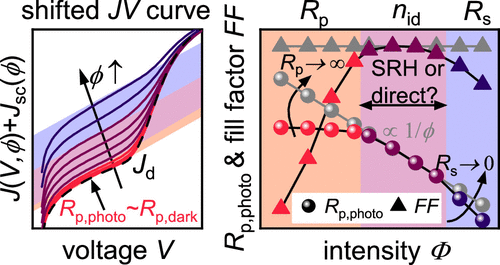Lübke, D.; Hartnagel, P.; Hülsbeck, M.; Kirchartz, T.
ACS Materials Au 2023, 3, 215
For indoor light harvesting, the adjustable band gap of molecular semiconductors is a significant advantage relative to many inorganic photovoltaic technologies. However, several challenges have to be overcome that include processability in nonhalogenated solvents, sufficiently high thicknesses (>250 nm) and high efficiencies at illuminances typically found in indoor environments. Here, we report on the development and application of new methods to quantify and identify performance losses based on thickness- and intensity-dependent current density–voltage measurements. Furthermore, we report on the fabrication of solar cells based on the blend PBDB-T:F-M processed in the nonhalogenated solvent o-xylene. In the low-intensity regime, insufficiently high shunt resistances limit the photovoltaic performance and by analyzing current density voltage–curves for solar cells with various shunt resistances we find that ∼100 kΩ cm2 are required at 200 lux. We provide a unified description of fill factor losses introducing the concept of light-intensity-dependent apparent shunts that originate from incomplete and voltage-dependent charge collection. In experiment and simulation, we show that good fill factors are associated with a photo-shunt inversely scaling with intensity. Intensity regions with photo-shunt resistances close to the dark-shunt resistance are accompanied by severe extraction losses. To better analyze recombination, we perform a careful analysis of the light intensity and thickness dependence of the open-circuit voltage and prove that trap-assisted recombination dominates the recombination losses at low light intensities.

Lübke, D.; Hartnagel, P.; Hülsbeck, M.; Kirchartz, T.
ACS Materials Au 2023, 3, 215
For indoor light harvesting, the adjustable band gap of molecular semiconductors is a significant advantage relative to many inorganic photovoltaic technologies. However, several challenges have to be overcome that include processability in nonhalogenated solvents, sufficiently high thicknesses (>250 nm) and high efficiencies at illuminances typically found in indoor environments. Here, we report on the development and application of new methods to quantify and identify performance losses based on thickness- and intensity-dependent current density–voltage measurements. Furthermore, we report on the fabrication of solar cells based on the blend PBDB-T:F-M processed in the nonhalogenated solvent o-xylene. In the low-intensity regime, insufficiently high shunt resistances limit the photovoltaic performance and by analyzing current density voltage–curves for solar cells with various shunt resistances we find that ∼100 kΩ cm2 are required at 200 lux. We provide a unified description of fill factor losses introducing the concept of light-intensity-dependent apparent shunts that originate from incomplete and voltage-dependent charge collection. In experiment and simulation, we show that good fill factors are associated with a photo-shunt inversely scaling with intensity. Intensity regions with photo-shunt resistances close to the dark-shunt resistance are accompanied by severe extraction losses. To better analyze recombination, we perform a careful analysis of the light intensity and thickness dependence of the open-circuit voltage and prove that trap-assisted recombination dominates the recombination losses at low light intensities.